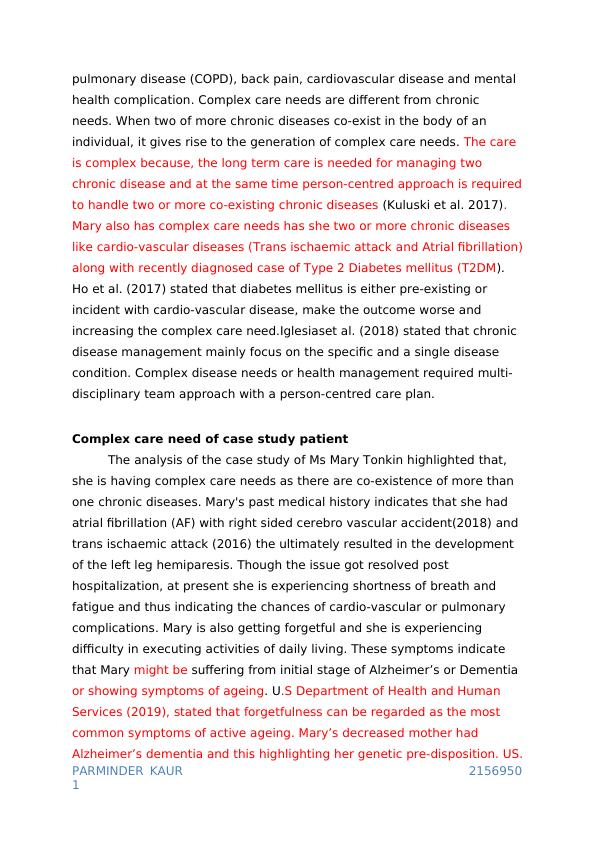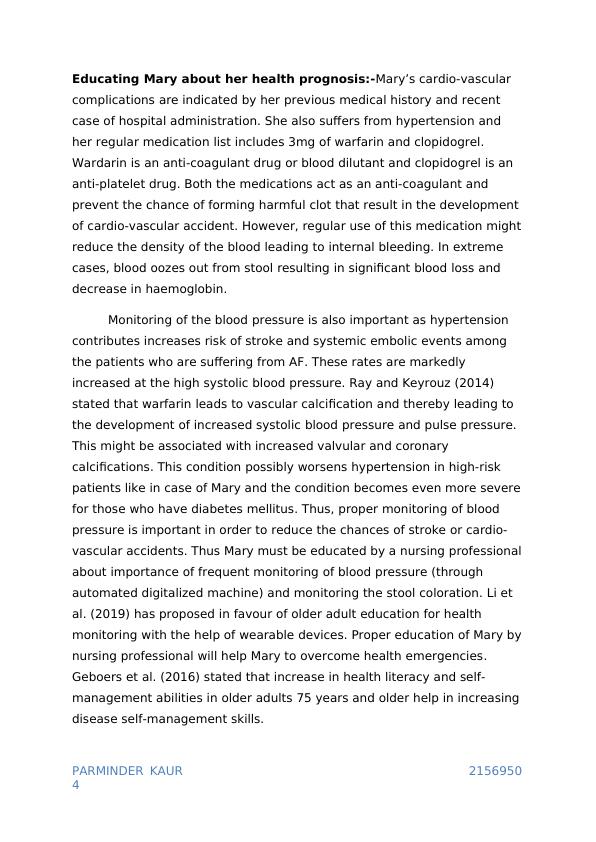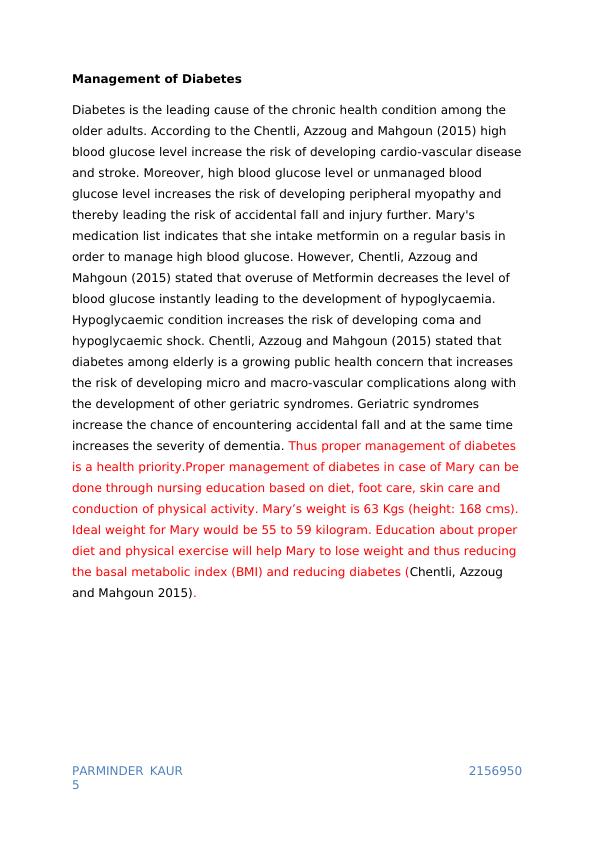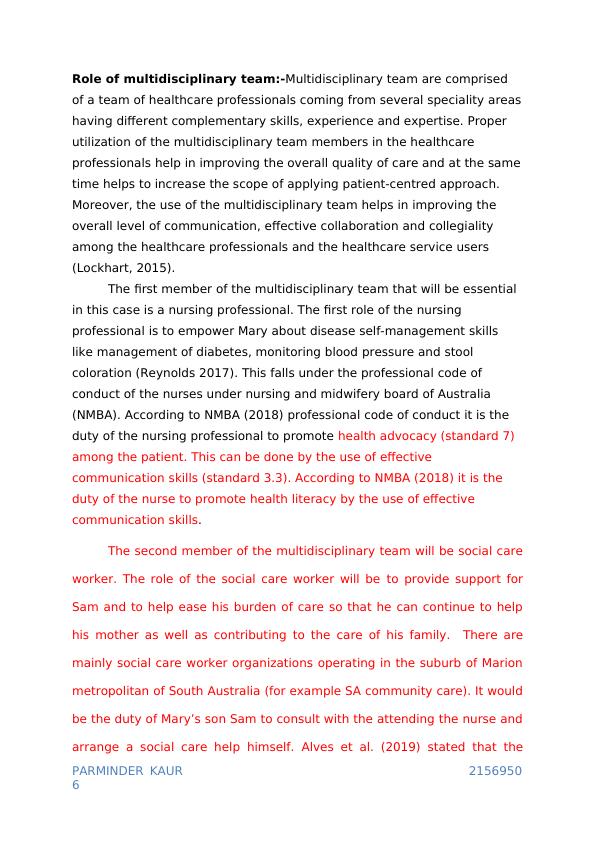Consumer-directed care Parminder Kaur Assignment
Added on 2022-08-22
21 Pages6238 Words26 Views
Running head: ASSIGNMENT 3
Name: - parminder kaur
Student Id: - 2156950
Topic: - 3003
Tittle:-Assignment 3: Case study essay
Introduction: - Consumer-directed care (CDC) is strictly followed in
Australia. CDC uplifts the principle of patient-centred care approach that
helps in improving the overall quality of life of the healthcare service
users (Australian Government Department of Health, 2019). The following
assignment is based on the case study of Mrs Mary Tonkin is a 79-year-old
widow who lives alone. She has three sons; two of them live in
Queensland while his younger son Sam lives with his family 20 minutes
drive from Mary. She has significant cardio-vascular complications and is
becoming forgetful and has also encountered accidental fall. She doesn’t
like hospital and wants to stay in her own home. The essay will focus on
the complex care needs of Mary followed by rationale behind the selected
complex care needs of Mary. This will be followed by highlighting the
healthcare professionals of the multidisciplinary team who will address the
concerns that are highlighted as clinical priority. At the end, the potential
barriers towards implementation of the therapy and the important
medication of choice for Mary will be highlighted with proper rationale.
Chronic and complex needs
According to the Australian Institute of Health and Welfare [AIHW]
(2019), chronic healthcare needs arise when a person is affected with
chronic diseases. Chronic diseases are defined as condition that last for
one year of more and demands ongoing medical attention and create a
barrier for conducting activities of daily living (CDC, 2019). The rate of
occurrence of chronic diseases is high in Australia. The chronic diseases
that are common in Australia are asthma, cancer, chronic obstructive
Name: - parminder kaur
Student Id: - 2156950
Topic: - 3003
Tittle:-Assignment 3: Case study essay
Introduction: - Consumer-directed care (CDC) is strictly followed in
Australia. CDC uplifts the principle of patient-centred care approach that
helps in improving the overall quality of life of the healthcare service
users (Australian Government Department of Health, 2019). The following
assignment is based on the case study of Mrs Mary Tonkin is a 79-year-old
widow who lives alone. She has three sons; two of them live in
Queensland while his younger son Sam lives with his family 20 minutes
drive from Mary. She has significant cardio-vascular complications and is
becoming forgetful and has also encountered accidental fall. She doesn’t
like hospital and wants to stay in her own home. The essay will focus on
the complex care needs of Mary followed by rationale behind the selected
complex care needs of Mary. This will be followed by highlighting the
healthcare professionals of the multidisciplinary team who will address the
concerns that are highlighted as clinical priority. At the end, the potential
barriers towards implementation of the therapy and the important
medication of choice for Mary will be highlighted with proper rationale.
Chronic and complex needs
According to the Australian Institute of Health and Welfare [AIHW]
(2019), chronic healthcare needs arise when a person is affected with
chronic diseases. Chronic diseases are defined as condition that last for
one year of more and demands ongoing medical attention and create a
barrier for conducting activities of daily living (CDC, 2019). The rate of
occurrence of chronic diseases is high in Australia. The chronic diseases
that are common in Australia are asthma, cancer, chronic obstructive

pulmonary disease (COPD), back pain, cardiovascular disease and mental
health complication. Complex care needs are different from chronic
needs. When two of more chronic diseases co-exist in the body of an
individual, it gives rise to the generation of complex care needs. The care
is complex because, the long term care is needed for managing two
chronic disease and at the same time person-centred approach is required
to handle two or more co-existing chronic diseases (Kuluski et al. 2017).
Mary also has complex care needs has she two or more chronic diseases
like cardio-vascular diseases (Trans ischaemic attack and Atrial fibrillation)
along with recently diagnosed case of Type 2 Diabetes mellitus (T2DM).
Ho et al. (2017) stated that diabetes mellitus is either pre-existing or
incident with cardio-vascular disease, make the outcome worse and
increasing the complex care need.Iglesiaset al. (2018) stated that chronic
disease management mainly focus on the specific and a single disease
condition. Complex disease needs or health management required multi-
disciplinary team approach with a person-centred care plan.
Complex care need of case study patient
The analysis of the case study of Ms Mary Tonkin highlighted that,
she is having complex care needs as there are co-existence of more than
one chronic diseases. Mary's past medical history indicates that she had
atrial fibrillation (AF) with right sided cerebro vascular accident(2018) and
trans ischaemic attack (2016) the ultimately resulted in the development
of the left leg hemiparesis. Though the issue got resolved post
hospitalization, at present she is experiencing shortness of breath and
fatigue and thus indicating the chances of cardio-vascular or pulmonary
complications. Mary is also getting forgetful and she is experiencing
difficulty in executing activities of daily living. These symptoms indicate
that Mary might be suffering from initial stage of Alzheimer’s or Dementia
or showing symptoms of ageing. U.S Department of Health and Human
Services (2019), stated that forgetfulness can be regarded as the most
common symptoms of active ageing. Mary’s decreased mother had
Alzheimer’s dementia and this highlighting her genetic pre-disposition. US.
PARMINDER KAUR 2156950
1
health complication. Complex care needs are different from chronic
needs. When two of more chronic diseases co-exist in the body of an
individual, it gives rise to the generation of complex care needs. The care
is complex because, the long term care is needed for managing two
chronic disease and at the same time person-centred approach is required
to handle two or more co-existing chronic diseases (Kuluski et al. 2017).
Mary also has complex care needs has she two or more chronic diseases
like cardio-vascular diseases (Trans ischaemic attack and Atrial fibrillation)
along with recently diagnosed case of Type 2 Diabetes mellitus (T2DM).
Ho et al. (2017) stated that diabetes mellitus is either pre-existing or
incident with cardio-vascular disease, make the outcome worse and
increasing the complex care need.Iglesiaset al. (2018) stated that chronic
disease management mainly focus on the specific and a single disease
condition. Complex disease needs or health management required multi-
disciplinary team approach with a person-centred care plan.
Complex care need of case study patient
The analysis of the case study of Ms Mary Tonkin highlighted that,
she is having complex care needs as there are co-existence of more than
one chronic diseases. Mary's past medical history indicates that she had
atrial fibrillation (AF) with right sided cerebro vascular accident(2018) and
trans ischaemic attack (2016) the ultimately resulted in the development
of the left leg hemiparesis. Though the issue got resolved post
hospitalization, at present she is experiencing shortness of breath and
fatigue and thus indicating the chances of cardio-vascular or pulmonary
complications. Mary is also getting forgetful and she is experiencing
difficulty in executing activities of daily living. These symptoms indicate
that Mary might be suffering from initial stage of Alzheimer’s or Dementia
or showing symptoms of ageing. U.S Department of Health and Human
Services (2019), stated that forgetfulness can be regarded as the most
common symptoms of active ageing. Mary’s decreased mother had
Alzheimer’s dementia and this highlighting her genetic pre-disposition. US.
PARMINDER KAUR 2156950
1

National Library of Medicine (2019) stated that Alzheimer has hereditary
component. People whose parents and siblings have Alzheimer’s have
higher risk of developing this condition. Complex care need for Mary
include management of the cardio-vascular health and T2DM. Heart
disease and dementia are co-related. According to the study conducted by
Justin, Turek and Hakim (2013), the presence of heart disease increases
the chance of developing dementia and thus increasing the complex care
needs. The presence of the cardio-vascular complications like AF, valvular
disease, coronary artery disease, myocardial infarction and heart failure
increases the chance of developing dementia. Mary has encountered
Right sided cerebro vascular accident, trans ischeamic attack. She has
hypertension and AF. The conditions are more severe among the older
adults who are 65 years and above. Ms Mary Tonkin is 79 years old and
thus increasing risk of developing dementia, a neurological disorder that is
characterised by the initial signs of amnesia. According to the National
Institutes of Health (NIH) (2017), the risk factors of heart disease are liked
to dementia. The presence of vascular complications increases the risk of
developing neurological complication and thus increasing the chance of
developing dementia among the older adults. NIH (2019) also highlighted
that presence of dementia and cardio-vascular complications hamper the
overall quality of life of the older adults and thereby increasing the
complex care needs. Mary Tonkin is havingrecently been diagnosed with
Type 2 Diabetes Mellitus (HbA1C 2 months ago=11.8) and thus increasing
her complex care need further.
Three specific needs of the patient:-
Assistance in conducting the activities of daily living for fall
prevention
Mary lives alone in a large family home and is 79 years old widow.
Edemekong, Bomgaars, Sukumaran and Levy (2019) stated that in order
to improve the overall quality of life and well-being and to increase the
PARMINDER KAUR 2156950
2
component. People whose parents and siblings have Alzheimer’s have
higher risk of developing this condition. Complex care need for Mary
include management of the cardio-vascular health and T2DM. Heart
disease and dementia are co-related. According to the study conducted by
Justin, Turek and Hakim (2013), the presence of heart disease increases
the chance of developing dementia and thus increasing the complex care
needs. The presence of the cardio-vascular complications like AF, valvular
disease, coronary artery disease, myocardial infarction and heart failure
increases the chance of developing dementia. Mary has encountered
Right sided cerebro vascular accident, trans ischeamic attack. She has
hypertension and AF. The conditions are more severe among the older
adults who are 65 years and above. Ms Mary Tonkin is 79 years old and
thus increasing risk of developing dementia, a neurological disorder that is
characterised by the initial signs of amnesia. According to the National
Institutes of Health (NIH) (2017), the risk factors of heart disease are liked
to dementia. The presence of vascular complications increases the risk of
developing neurological complication and thus increasing the chance of
developing dementia among the older adults. NIH (2019) also highlighted
that presence of dementia and cardio-vascular complications hamper the
overall quality of life of the older adults and thereby increasing the
complex care needs. Mary Tonkin is havingrecently been diagnosed with
Type 2 Diabetes Mellitus (HbA1C 2 months ago=11.8) and thus increasing
her complex care need further.
Three specific needs of the patient:-
Assistance in conducting the activities of daily living for fall
prevention
Mary lives alone in a large family home and is 79 years old widow.
Edemekong, Bomgaars, Sukumaran and Levy (2019) stated that in order
to improve the overall quality of life and well-being and to increase the
PARMINDER KAUR 2156950
2

level of safety quotient, it is recommended for older adults (75 years and
above) to received manual assistance in order to conduct activities of
daily living. Edemekong, Bomgaars, Sukumaran and Levy (2019) stated
that the term activities of daily living (ADLs) are collectively used to
described the fundamental skills that are require to conduct activates like
mobility, bathing and eating. ADL is used as an indicator of the functional
status of a person. The inability to perform the ADLs increases the level of
dependence over other individuals. The case study highlights that Mary
has noticed her health is declining, making it difficult for her to execute
gardening and cleaning. She is also experiencing fatigue along with
shortness of breath and high level of perspiration (diaphoretic). This
justifies the importance of manual assistance at home. The case study
also highlights that Mary has developed left-sided leg hemiparesis after
encountering stroke (2018). Though she manages to walk with the help of
aid (walking stick), however, her health condition demands manual
assistance. Quigley (2016) stated that people who are suffering from the
left-sided leg hemiparesis are prone to encounter the accidental fall. The
recent case history also indicated that Mary has encountered accidental
fall at home resulting in colles with internal fixation (2018). Lui and
Nguyen (2018) argued that stroke is one of the leading causes of
worldwide disabilities and mortality. Post stroke cognitive impairment
along with neuropsychological problems increase the chance of fall.
Cognitive problems are also indicated in case of Mary she reported to
keeping frozen food item in the cupboard rather than refrigerating.
Edemekong, Bomgaars, Sukumaran and Levy (2019) highlighted in their
study that cognitive dysfunction and cardio-vascular condition increase
the risk of accidental fall and thus increasing the chances of fatal injury.
Fall-related injury will be detrimental for Mary as she is 79-year old and
she might have brittle bone, common among post menopausal women. (Ji
& Yu, 2015). Taking assistance in conducting the activities of daily living
will reduce the chances of accidental fall among the older adults and thus
improving the overall quality of life.
PARMINDER KAUR 2156950
3
above) to received manual assistance in order to conduct activities of
daily living. Edemekong, Bomgaars, Sukumaran and Levy (2019) stated
that the term activities of daily living (ADLs) are collectively used to
described the fundamental skills that are require to conduct activates like
mobility, bathing and eating. ADL is used as an indicator of the functional
status of a person. The inability to perform the ADLs increases the level of
dependence over other individuals. The case study highlights that Mary
has noticed her health is declining, making it difficult for her to execute
gardening and cleaning. She is also experiencing fatigue along with
shortness of breath and high level of perspiration (diaphoretic). This
justifies the importance of manual assistance at home. The case study
also highlights that Mary has developed left-sided leg hemiparesis after
encountering stroke (2018). Though she manages to walk with the help of
aid (walking stick), however, her health condition demands manual
assistance. Quigley (2016) stated that people who are suffering from the
left-sided leg hemiparesis are prone to encounter the accidental fall. The
recent case history also indicated that Mary has encountered accidental
fall at home resulting in colles with internal fixation (2018). Lui and
Nguyen (2018) argued that stroke is one of the leading causes of
worldwide disabilities and mortality. Post stroke cognitive impairment
along with neuropsychological problems increase the chance of fall.
Cognitive problems are also indicated in case of Mary she reported to
keeping frozen food item in the cupboard rather than refrigerating.
Edemekong, Bomgaars, Sukumaran and Levy (2019) highlighted in their
study that cognitive dysfunction and cardio-vascular condition increase
the risk of accidental fall and thus increasing the chances of fatal injury.
Fall-related injury will be detrimental for Mary as she is 79-year old and
she might have brittle bone, common among post menopausal women. (Ji
& Yu, 2015). Taking assistance in conducting the activities of daily living
will reduce the chances of accidental fall among the older adults and thus
improving the overall quality of life.
PARMINDER KAUR 2156950
3

Educating Mary about her health prognosis:-Mary’s cardio-vascular
complications are indicated by her previous medical history and recent
case of hospital administration. She also suffers from hypertension and
her regular medication list includes 3mg of warfarin and clopidogrel.
Wardarin is an anti-coagulant drug or blood dilutant and clopidogrel is an
anti-platelet drug. Both the medications act as an anti-coagulant and
prevent the chance of forming harmful clot that result in the development
of cardio-vascular accident. However, regular use of this medication might
reduce the density of the blood leading to internal bleeding. In extreme
cases, blood oozes out from stool resulting in significant blood loss and
decrease in haemoglobin.
Monitoring of the blood pressure is also important as hypertension
contributes increases risk of stroke and systemic embolic events among
the patients who are suffering from AF. These rates are markedly
increased at the high systolic blood pressure. Ray and Keyrouz (2014)
stated that warfarin leads to vascular calcification and thereby leading to
the development of increased systolic blood pressure and pulse pressure.
This might be associated with increased valvular and coronary
calcifications. This condition possibly worsens hypertension in high-risk
patients like in case of Mary and the condition becomes even more severe
for those who have diabetes mellitus. Thus, proper monitoring of blood
pressure is important in order to reduce the chances of stroke or cardio-
vascular accidents. Thus Mary must be educated by a nursing professional
about importance of frequent monitoring of blood pressure (through
automated digitalized machine) and monitoring the stool coloration. Li et
al. (2019) has proposed in favour of older adult education for health
monitoring with the help of wearable devices. Proper education of Mary by
nursing professional will help Mary to overcome health emergencies.
Geboers et al. (2016) stated that increase in health literacy and self-
management abilities in older adults 75 years and older help in increasing
disease self-management skills.
PARMINDER KAUR 2156950
4
complications are indicated by her previous medical history and recent
case of hospital administration. She also suffers from hypertension and
her regular medication list includes 3mg of warfarin and clopidogrel.
Wardarin is an anti-coagulant drug or blood dilutant and clopidogrel is an
anti-platelet drug. Both the medications act as an anti-coagulant and
prevent the chance of forming harmful clot that result in the development
of cardio-vascular accident. However, regular use of this medication might
reduce the density of the blood leading to internal bleeding. In extreme
cases, blood oozes out from stool resulting in significant blood loss and
decrease in haemoglobin.
Monitoring of the blood pressure is also important as hypertension
contributes increases risk of stroke and systemic embolic events among
the patients who are suffering from AF. These rates are markedly
increased at the high systolic blood pressure. Ray and Keyrouz (2014)
stated that warfarin leads to vascular calcification and thereby leading to
the development of increased systolic blood pressure and pulse pressure.
This might be associated with increased valvular and coronary
calcifications. This condition possibly worsens hypertension in high-risk
patients like in case of Mary and the condition becomes even more severe
for those who have diabetes mellitus. Thus, proper monitoring of blood
pressure is important in order to reduce the chances of stroke or cardio-
vascular accidents. Thus Mary must be educated by a nursing professional
about importance of frequent monitoring of blood pressure (through
automated digitalized machine) and monitoring the stool coloration. Li et
al. (2019) has proposed in favour of older adult education for health
monitoring with the help of wearable devices. Proper education of Mary by
nursing professional will help Mary to overcome health emergencies.
Geboers et al. (2016) stated that increase in health literacy and self-
management abilities in older adults 75 years and older help in increasing
disease self-management skills.
PARMINDER KAUR 2156950
4

Management of Diabetes
Diabetes is the leading cause of the chronic health condition among the
older adults. According to the Chentli, Azzoug and Mahgoun (2015) high
blood glucose level increase the risk of developing cardio-vascular disease
and stroke. Moreover, high blood glucose level or unmanaged blood
glucose level increases the risk of developing peripheral myopathy and
thereby leading the risk of accidental fall and injury further. Mary's
medication list indicates that she intake metformin on a regular basis in
order to manage high blood glucose. However, Chentli, Azzoug and
Mahgoun (2015) stated that overuse of Metformin decreases the level of
blood glucose instantly leading to the development of hypoglycaemia.
Hypoglycaemic condition increases the risk of developing coma and
hypoglycaemic shock. Chentli, Azzoug and Mahgoun (2015) stated that
diabetes among elderly is a growing public health concern that increases
the risk of developing micro and macro-vascular complications along with
the development of other geriatric syndromes. Geriatric syndromes
increase the chance of encountering accidental fall and at the same time
increases the severity of dementia. Thus proper management of diabetes
is a health priority.Proper management of diabetes in case of Mary can be
done through nursing education based on diet, foot care, skin care and
conduction of physical activity. Mary’s weight is 63 Kgs (height: 168 cms).
Ideal weight for Mary would be 55 to 59 kilogram. Education about proper
diet and physical exercise will help Mary to lose weight and thus reducing
the basal metabolic index (BMI) and reducing diabetes (Chentli, Azzoug
and Mahgoun 2015).
PARMINDER KAUR 2156950
5
Diabetes is the leading cause of the chronic health condition among the
older adults. According to the Chentli, Azzoug and Mahgoun (2015) high
blood glucose level increase the risk of developing cardio-vascular disease
and stroke. Moreover, high blood glucose level or unmanaged blood
glucose level increases the risk of developing peripheral myopathy and
thereby leading the risk of accidental fall and injury further. Mary's
medication list indicates that she intake metformin on a regular basis in
order to manage high blood glucose. However, Chentli, Azzoug and
Mahgoun (2015) stated that overuse of Metformin decreases the level of
blood glucose instantly leading to the development of hypoglycaemia.
Hypoglycaemic condition increases the risk of developing coma and
hypoglycaemic shock. Chentli, Azzoug and Mahgoun (2015) stated that
diabetes among elderly is a growing public health concern that increases
the risk of developing micro and macro-vascular complications along with
the development of other geriatric syndromes. Geriatric syndromes
increase the chance of encountering accidental fall and at the same time
increases the severity of dementia. Thus proper management of diabetes
is a health priority.Proper management of diabetes in case of Mary can be
done through nursing education based on diet, foot care, skin care and
conduction of physical activity. Mary’s weight is 63 Kgs (height: 168 cms).
Ideal weight for Mary would be 55 to 59 kilogram. Education about proper
diet and physical exercise will help Mary to lose weight and thus reducing
the basal metabolic index (BMI) and reducing diabetes (Chentli, Azzoug
and Mahgoun 2015).
PARMINDER KAUR 2156950
5

End of preview
Want to access all the pages? Upload your documents or become a member.
Related Documents
Assignment on Patient Care - Introductionlg...
|17
|4561
|18
Mary Young Case Studylg...
|5
|627
|52
Chronic Health Case Study on Heart Failurelg...
|9
|2827
|42
Nursing Care for Older Adults with Complex Needslg...
|17
|4898
|70
Chronic Illness: Risk Factors and Health Services in Australialg...
|9
|2532
|267
PART 11: Details about chronic illnesslg...
|11
|2513
|386
